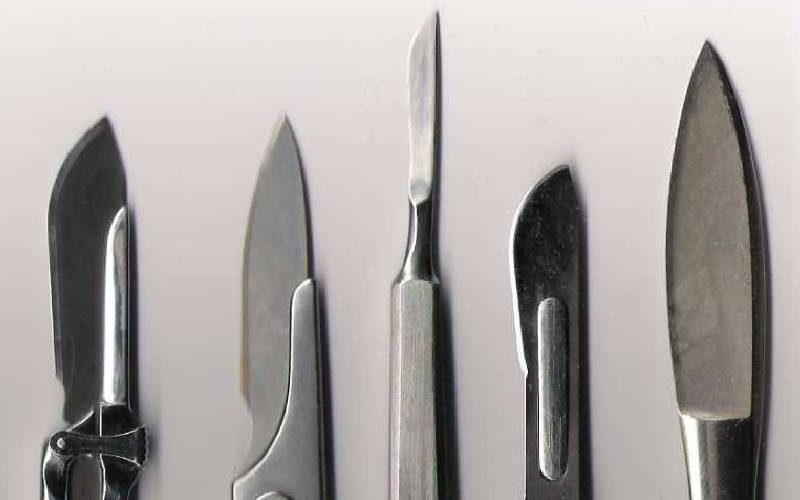
C-Section should be done by a doctor and mostly only in women with high-risk pregnancies. [File, Standard]
Kenya is recording a high number of women delivering through Caesarian Section, but with dire consequences including death.
Besides Kenya, other African countries have similar gloomy outcomes: one in every 100 women who deliver via CS, die, according to the Lancet medical journal.
In Kenya, the introduction of Linda Mama free maternity care in 2016 has seen the number of women delivering in hospitals increase in tandem with CS deliveries, which have more than doubled.
Yet, C-Section should be done by a doctor and mostly only in women with high-risk pregnancies.
Dr Helen Allott, a senior specialist at the Liverpool School of Tropical Medicine, attributes the deaths to haemorrhage (excessive bleeding), wanting surgical skills and technology by healthcare providers before, during and after deliveries.
Other causes include anaesthesia-related deaths and abscesses (infections), which may spread to other organs in the body, said Dr Allott also a consultant obstetrician.
Dr Allott says some medics “lack skills on the importance of relapse, taking women back to the theatre early enough.”
Kenya records 342 maternal deaths per 100,000 live births, with 36 post-postnatal care for newborns, according to the Ministry of Health.
Contributors of postpartum haemorrhage include prolonged labour, failure by the uterus to contract at birth, uterine rupture, tearing of the vagina, more so among mothers with big babies, trauma at birth and retention of the placenta.
Other causes of excessive bleeding are tearing in the cervix, blood clotting disorders, multiple pregnancies, and infections which account for mortality rates being 12 times higher at the second stage of labour.
Dr Allott pegs the number of expectant mothers in need of CS at not more than 15 per cent.
She attributes the rise to, among other factors, “lack of information or rather selective ignorance”.

Though the number of CS deliveries is increasing, Linda Mama in general has benefitted more women. [File, Standard]
According to her, healthcare professionals need to explain the risks to women to make better-informed decisions.
“Virginal natural birth has advantages in the longer term. If there are women who want more children, and after being introduced to the CS, the operation becomes riskier,” she explains.
Dr Allot explains that excessive bleeding during birth results in a woman losing red blood cells that carry oxygen all over the body and loose coating factor, a condition that results in death.
The Linda Mama program in which deliveries are covered by the National Health Insurance Fund (NHIF), has seen the number of CS deliveries increase to 14.9 per cent by 2019 with Nairobi reporting more than 25 per cent, while Mandera has the least CS deliveries at only five per cent.
In a previous interview, Prof Marleen Temmerman, the chair, the Department of Obstetrics and Gynecology, Aga Khan University Hospital, Nairobi lamented the increasing number of unnecessary C-sections that are not medically proven.
Prof Temmerman blamed doctors for the rising numbers of CS deliveries arguing that most are reluctant to respond to deliveries at night.
Instead, she says, they schedule them at their preferred hours besides mostly, private hospitals using C-Sections as a cash cow.
“At least 60 per cent of maternity budget was used for C-Section in Kenya after NHIF announced it would cater for bills. Were these operations necessary?” posed Prof Temmerman adding that some hospitals inquire about the type of medical cover from clients for the sole purpose of encouraging C-Section.
Some doctors, she added, also prefer surgery for fear of being blamed in case a woman develops complications and dies during natural birth.
NHIF CEO Dr Peter Kamunyo says “though the number of CS deliveries is increasing, the program, in general, has benefitted more women who would have otherwise not had access to hospital delivery services.”
But Charles Ameh, an associate professor in global health, Liverpool School of Tropical Medicine, said maternal health indicators reveal very high risks of deaths reported during pregnancy and childbirth.
Kenya though, said Prof Ameh, is not among the worst hit as it has skilled health professionals, and its mortality rates thus, falls towards the lower half of the spectrum, unlike Sudan and Chad.
Dr Ameh hailed the Linda Mama Program as one of the major milestones in the fight against maternal and infant mortality rates in Kenya: the maternal mortality ratio and the neonatal mortality rate stood at 362 per 100,000 live births, and 22 per 1,000 live births respectively, prior to its introduction.
Dr Ameh noted that uterotonic drugs, which prevent bleeding at birth, should be supplied to all hospitals offering delivery services besides training healthcare providers on dispensing them.
 The Standard Group Plc is a multi-media organization with investments in media platforms spanning newspaper print
operations, television, radio broadcasting, digital and online services. The Standard Group is recognized as a
leading multi-media house in Kenya with a key influence in matters of national and international interest.
The Standard Group Plc is a multi-media organization with investments in media platforms spanning newspaper print
operations, television, radio broadcasting, digital and online services. The Standard Group is recognized as a
leading multi-media house in Kenya with a key influence in matters of national and international interest.











